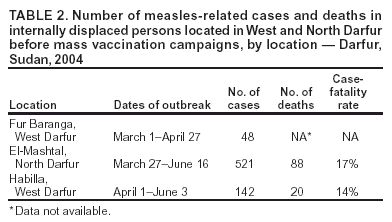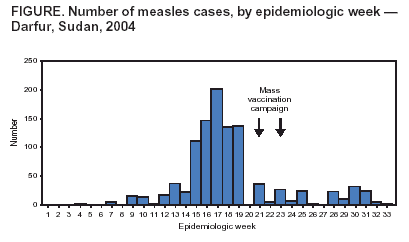 |
|
|
|
|
|
|
| ||||||||||
|
|
|
|
|
|
|
||||
| ||||||||||
|
|
|
|
|
Persons using assistive technology might not be able to fully access information in this file. For assistance, please send e-mail to: mmwrq@cdc.gov. Type 508 Accommodation and the title of the report in the subject line of e-mail. Emergency Measles Control Activities --- Darfur, Sudan, 2004The Darfur region of Sudan, composed of three states with a population of approximately six million, has experienced civil conflict during the previous year, resulting in the internal displacement of approximately one million residents and an exodus of an estimated 170,000 persons to neighboring Chad. The conflict has left a vulnerable population with limited access to food, health care, and other basic necessities. In addition, measles vaccination coverage has been adversely affected; in 2003, coverage was reported to be 46%, 57%, and 77% in North, West, and South Darfur, respectively. This report describes measles-control activities in Darfur region conducted by the Federal Ministry of Health (FMOH) in Sudan in collaboration with the United Nations and nongovernmental organizations (NGOs) during March--August 2004. Ongoing measles transmission in camps for internally displaced persons (IDPs) and neighboring communities in Darfur led to a regionwide measles vaccination campaign targeting all children aged 9 months--15 years, resulting in a reduction in reported measles cases. Once security is improved, ongoing efforts to increase measles vaccine coverage will be required to eliminate persistent susceptibility to measles in the Darfur population. Measles Vaccination ActivitiesDuring March--April 2004, the Expanded Program on Immunization (EPI) at FMOH received reports of measles outbreaks among displaced populations in West and North Darfur. In response to these outbreaks, the state ministries of health and various NGOs conducted vaccination campaigns in IDP camps and neighboring communities, targeting children aged 9 months--5 years; these campaigns vaccinated approximately 80,000 children. In addition, clinics were established in IDP camps to vaccinate current and incoming residents. Despite these measures, measles virus transmission continued to occur both within the camps and in neighboring communities. In early April, FMOH, the World Health Organization (WHO), and UNICEF conducted an assessment of the feasibility of a regionwide measles vaccination campaign in the context of lack of security, population movements, and the approaching rainy season. State-level EPI managers reported that approximately 83% of children aged 9 months--15 years in the region were accessible. The majority of the inaccessible areas were in West Darfur, from which much of the population had fled to Chad. On the basis of these assessments, a measles vaccination campaign targeting children aged 9 months--15 years was planned in the accessible areas of the Darfur region. Authorities hoped that the negotiations between opposing parties necessary to permit widespread access to vaccination also might result in alleviation of civil conflict. Donor agencies pledged resources toward campaign activities, including renewal of the vaccine cold chain (i.e., maintaining proper vaccine temperatures during storage and handling to preserve potency) and reestablishment of EPI services. Because of widespread malnutrition and low poliomyelitis vaccine coverage, polio vaccination and vitamin A supplementation for children aged <5 years were included in the campaign. A technical group composed of provincial health staff, NGOs, and international partners was established for campaign planning. State- and district-level staff participated in workshops in Khartoum during the first half of May 2004 to review campaign guidelines and develop a schedule for campaign planning. Extensive social mobilization was undertaken through mass media and community-level activities. In late May, training sessions were held for 6,259 vaccinators, 522 team leaders, and 206 supervisors. A mass measles vaccination campaign was launched on June 5 in South Darfur and on June 12 in West and North Darfur and continued for 10 days in each state. Activities included vaccination using a combination of fixed posts and outreach immunization teams, the use of checklists to monitor vaccination sessions, social mobilization activities, and surveillance for adverse events after vaccination. In addition, rapid convenience surveys were used to monitor coverage in hard-to-reach areas. At the state level, meetings were held at the end of each working day to review progress and address problems. Tally sheets were used to monitor campaign coverage, and data were sent to the federal level for compilation and analysis. Vaccination sites included 500 fixed centers, 1,088 temporary posts, and 189 mobile teams. Approximately 93% of the accessible population and 77% of the total target population were vaccinated during the campaign (Table 1). Coverage were highest in South Darfur, an area with limited conflict, and lowest in West Darfur, where a substantial percentage of the population was inaccessible because of lack of security. Officials negotiated an agreement with rebel forces, allowing campaign staff to enter conflict areas in South Darfur, but were unable to negotiate similar agreements in West Darfur. In addition, the start of the rainy season limited access in parts of West Darfur. Measles SurveillanceDuring the measles outbreak in Darfur, WHO collaborated with FMOH and other partners to develop a system for routine surveillance and early outbreak detection of 12 epidemic diseases, including measles (1). Data are compiled at the state level and transmitted to FMOH weekly. Alert thresholds for outbreaks were agreed upon for selected diseases, and a surveillance bulletin was developed to disseminate data to key stakeholders. During the course of establishing surveillance in the IDP camps, three serologically confirmed measles outbreaks were investigated retrospectively. A total of 725 measles cases and 108 deaths were identified in outbreaks that occurred during March--June in West and North Darfur (Table 2). Transmission of measles virus continued to be observed in Darfur after completion of the mass campaign (Figure). Of the 89 measles patients identified during July 10--August 6, a total of 45 (51%) were from West Darfur, 33 (37%) from North Darfur, and 11 (12%) from South Darfur. Maintaining high-quality surveillance is necessary for enabling early detection of and response to outbreaks. When security improves, FMOH plans to repeat a mass campaign in these areas; this step will be critical in protecting remaining susceptible persons, thereby stopping transmission. Reported by: EA Elsayed, MD, N Mousa, MD, Federal Ministry of Health of Sudan. A Dabbagh, MD, World Health Organization, Geneva, Switzerland. H El-Bushra, MD, F Mahoney, MD, World Health Organization Eastern Mediterranean Regional Office, Cairo, Egypt. S Haithami, MD, H El-Sakka, MD, G Sabitenelli, MD, World Health Organization; S Agbo, MD, UNICEF, Khartoum, Sudan. R Nandy, MBBS, L Cairns, MD, Global Immunization Div, National Immunization Program, CDC. Editorial Note:In October 2003, FMOH developed a comprehensive strategy for measles mortality reduction in Sudan based on the WHO-UNICEF campaign (2). The strategy includes increasing routine measles vaccination coverage among infants, providing a second opportunity for measles immunization, strengthening measles surveillance, and improving case management of children with measles. The strategy calls for a nationwide supplemental vaccination campaign for all children aged 9 months--15 years. A pilot campaign was conducted in four northern states in January 2004, after which plans were under way to cover the remainder of the northern states in Sudan in late 2004. The civil conflict in Darfur created a public health emergency, necessitating the modification of these plans for immediate response in Darfur. Outbreaks of measles are common among refugee and displaced populations, and measles often is a leading cause of death in these settings (3--7). Overcrowding increases the likelihood of infection, and young age and malnutrition are associated with increased severity of disease (4). Consequently, measles vaccination is a priority health intervention for areas affected by humanitarian emergencies. The SPHERE Project guidelines (8), revised in 2004, provide minimum standards in disaster response. These guidelines recommend measles vaccination at the earliest opportunity for all children aged 6 months--15 years (8). Recent experience in Afghanistan suggests that large-scale measles vaccination campaigns are possible in a country affected by conflict and can substantially limit morbidity and mortality attributable to measles (9,10). In addition to measles control efforts in Darfur, measles vaccination campaigns were conducted during June--August 2004 in the 10 refugee camps in eastern Chad to which refugees from Darfur had fled. Reported vaccine coverage in these camp-based campaigns ranged from 80% to 92%. As of August 2, these camps housed 165,685 persons. Sixty-five percent of weekly mortality reports and 60% of weekly morbidity reports from these camps are available for June 28--July 25 (United Nations High Commissioner for Refugees, unpublished data, 2004); during this period, 66 measles cases and 15 measles deaths were reported. The high case-fatality rate (CFR) observed in Darfur and refugee camps in neighboring Chad is consistent with studies in similar settings and emphasizes the importance of providing measles vaccination as early as possible in such populations. The initial response to the measles outbreaks in Darfur included vaccination campaigns for children aged <5 years in IDP camps and surrounding communities and the vaccination of incoming residents in these camps. Although these efforts were important for providing protection to individual children who were vaccinated, they had limited impact on virus transmission because of the restricted target age group, the continuous movement of the displaced population, and the low vaccination coverage in the surrounding communities. The unique circumstances in Darfur presented challenges to the rapid mobilization of a mass measles vaccination campaign. The substantial numbers of displaced persons residing throughout broad geographic areas created a situation in which the entire population needed to be targeted. Considerable resources were needed to purchase vaccine, reestablish the cold chain, and support operational aspects of the campaign. In addition, the challenging physical environment and lack of security in the region presented formidable logistic constraints that required extensive planning and support. The findings in this report are subject to at least three limitations. First, the retrospective outbreak investigations described in this report might have resulted in incomplete ascertainment of measles cases or measles deaths. Either of these factors could lead to an inaccurate estimate of CFRs. Second, coverage figures for these campaigns were calculated by dividing the total number of doses administered by the estimated target population of the community before the conflict. No coverage surveys were conducted after these campaigns. Finally, coverage was reported to be lowest in the insecure areas of West Darfur. However, some of the target population might have relocated to Chad, thus resulting in falsely low coverage estimates. Despite low coverage in some areas, this campaign resulted in the vaccination of approximately three quarters of the total target population and appears to have reduced morbidity and mortality attributable to measles. This experience demonstrates that a large-scale vaccination campaign can rapidly and successfully be conducted in an area of conflict. However, a multisectoral approach with commitment of all stakeholders is needed to ensure success. The future challenge will be to ensure rebuilding of the EPI infrastructure and reestablishing of routine vaccination services when the security situation is normalized. Acknowledgments The measles control activities in Darfur are funded, in part, by U.K. Dept for International Development, European Commission Health Office, Government of Japan, Government of Italy, U.S. Agency for International Development, CDC. References
Table 1  Return to top. Table 2  Return to top. Figure  Return to top.
Disclaimer All MMWR HTML versions of articles are electronic conversions from ASCII text into HTML. This conversion may have resulted in character translation or format errors in the HTML version. Users should not rely on this HTML document, but are referred to the electronic PDF version and/or the original MMWR paper copy for the official text, figures, and tables. An original paper copy of this issue can be obtained from the Superintendent of Documents, U.S. Government Printing Office (GPO), Washington, DC 20402-9371; telephone: (202) 512-1800. Contact GPO for current prices. **Questions or messages regarding errors in formatting should be addressed to mmwrq@cdc.gov.Page converted: 9/30/2004 |
|||||||||
This page last reviewed 9/30/2004
|